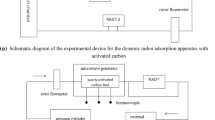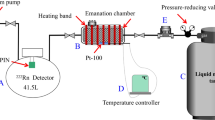Abstract
Underground low-background laboratories have a very large demand for radon reduction in their working environments. Therefore, in this paper, we have constructed a system for low-temperature activated carbon adsorption of radon by using air cooler and measured the dynamic adsorption coefficients of activated carbon on radon at room temperature and at a low temperature below − 50 °C. The experimental results show that the activated carbon dynamic adsorption coefficient reaches 688.79 L/g at a temperature of − 63.35 °C and a pressure of 3.5 atmospheres, which is more than 70 times higher than that at room temperature. During the experiments, problems of effective regulation were identified that need to be further addressed.



Similar content being viewed by others
References
Pushkin K et al (2018) Study of radon reduction in gases for rare event search experiments. Nucl Instrum Methods Phys Res Sect A 903:267–276
Cao LL et al (2005) Summarization about the development of radon moving mechanism. Research 28(03):302–306
Zhang JW et al (2020) Background study on radioactive radon in CCD dark matter experiment. J Jiamusi Univ (Natural Science Edition) 38(05):151–154
Mi YH et al (2015) Monitoring of radon concentration in the air of China Jinping Underground Laboratory, China. Sciencepaper 10(23):2783–2785
Cheng JP et al (2012) Progress of underground laboratory and very low background physics experiments in Jinping, China. In: Proceedings of the 2012 Annual Academic Conference of the Radiation Protection Branch, pp 16–22
Planinić J et al (2003) Radon exposure and lung cancer. J Radioanal Nucl Chem 256:349–352
Tirmarche M et al (2011) Lung cancer risk from radon and progeny and statement on radon. Ann ICRP 40(1):1–64
Mitchell Austin L et al (2016) Lung cancer risk from radon in marcellus shale gas in Northeast U.S. Homes. Risk Anal 36(11):2105–2119
Mjönes L et al (2005) Cancer risks from radon in indoor air and drinking water in Sweden, The Swedish Radiation Protection Authority’s risk assessment, Radio activity in the. Environment 7:604–611
Qiu SK (2001) Appreciation of radon risk and evaluation. Radiat Prot Bull 21(06):3–7
Lubin JH et al (2003) Risk of lung cancer and residential radon: pooled results of two studies in China. Chin J Radiol Health 04:193–197
Shen FJ (2008) Hazards and protection of indoor radon gas. Chin J Radiol Health 2:206–207
Pan ZQ (2003) Exposure resulted from radon and its decay products in air in China. Radiat Prot 23(03):129–137
Pocar A (2003) Low background techniques and experimental challenges for Borexino and its nylon vessels. Princeton University, Princeton
Wang YX et al (2017) Study on radon adsorption of activated carbon in low temperature condition. Atom Energy Sci Technol 51(11):2107–2112
Feng X (2015) Research on high efficient activated carbon adsorption technology of radon. University of South China, China
Kitagawa H et al (1983) Basics and design of adsorption. Chemical Industry Press
Tachimoto E et al (2002) Application technology of activated carbon-its maintenance management and problems. Southeast University Press, Nanjing, pp 164–166
Guo LT et al (1994) Study on the charcoal delay bed for radioactive noble gases. Radiat Prot 14(1):15–24
El Samman H et al (2002) Temperature and humidity consideration for calculating airborne 222Rn using activated charcoal canisters. Health Phys 83(1):97–104
Zikovsky L (2001) Temperature dependence of adsorption coefficients of 222Rn on activated charcoal determined by adsorption-desorption method. Physics 80(2):175–176
Feng SJ et al (2010) Dynamic adsorption property of xenon on activated carbon and carbon molecular sieves. J Nucl Radiochem 32(05):274–279
Xie DF et al (2011) Factors influencing dynamic adsorption of noble gases by activated carbon. Radiat Prot 31(02):105–108
Feng X et al (2016) Research on high pressure adsorption of radon on activated carbon. At. Energy Sci. Technol. 50(04):763–768
Underhill DW, et al (1980) Review of the adsorption of radioactive krypton and xenon on activated charcoal. In: 16th DOE Nuclear Air Cleaning Conference, Session 3
Xie DF et al (2011) Study on the influence of radon dynamic adsorption in activated carbon. University of South China, Hengyang
Acknowledgements
This work is supported by Beijing Natural Science Foundation (Grant No. 1202024), Yalong River Joint Fund of the National Natural Science Foundation of China and Yalong River Hydropower Development Co., Ltd (Grant No. U1865208).
Author information
Authors and Affiliations
Corresponding authors
Additional information
Publisher's Note
Springer Nature remains neutral with regard to jurisdictional claims in published maps and institutional affiliations.
Rights and permissions
About this article
Cite this article
Li, C., Tang, Q., Feng, X. et al. Construction of a low-temperature activated carbon radon adsorption system using air cooler. J Radioanal Nucl Chem 331, 1839–1845 (2022). https://doi.org/10.1007/s10967-022-08270-9
Received:
Accepted:
Published:
Issue Date:
DOI: https://doi.org/10.1007/s10967-022-08270-9




